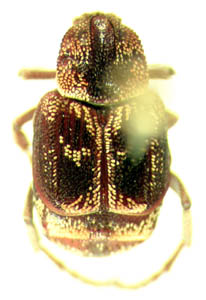| |
|
| Classification |
........Valgus
canaliculatus
(Olivier, 1789)
........Valgus canaliculatus (Olivier, 1789:69) (valid name)
........Cetonia canaliculata Olivier, 1789:69 (original combination)
........Trichius variegatus Palisot de Beauvois (original combination)
........Valgus serricollis Fitch, 1858: 697 (junior synonym
)
........Valgus minutus Casey, 1909:283
(junior synonym) |
| 
|
|
| male |
female |
Valgus
canaliculatus. Images by K. A. Swoboda |
|
Map
showing the distribution of Valgus canaliculatus |
|
| |
| Cetoniinae Tribes
|
| |
| |
| Cetoniinae
Taxa Map |
| Key
to species of Valgini
|
| |
| |
| |
| |
| |
| |
| |
| |
| |
| |
| |
| |
| |
| |
| |
| |
| |
| |
| |
| |
Description:
Pronotal disc serrate along lateral edges, transverse medial ridges
well developed, basal margin rounded; female with acuminate pygidial
spine with central groove near apex, groove lacking irregular lateral
serrations, moderately convex (in dorsal view); first segment of posterior
tarsus as long as segments two and three combined in males, as long
as segments two, three and four combined in females; both sexes brown
with dark setae, patches of light-colored setae on pronotum, elytra,
propygidium, pygidium, females with less light-colored setae than males,
males with dense patch of yellow setae on abdominal sternites; length
4.0-5.0mm.
|
| |
| |
| |
| |
| |
| |
| |
| |
| |
| |
Distribution: Eastern
United States. States include: ALABAMA, ARKANSAS, DELAWARE, DISTRICT OF COLUMBIA, FLORIDA, GEORGIA, ILLINOIS,
INDIANA, IOWA, KENTUCKY, LOUISIANA, MARYLAND, MICHIGAN, MISSOURI, NEW JERSEY, NORTH CAROLINA,
OHIO, OKLAHOMA, PENNSYLVANIA, SOUTH CAROLINA, TENNESSEE, TEXAS, VIRGINIA, andWEST
VIRGINIA.
|
| |
| |
| |
| |
| |
| |
Biological
Data: Valgus canaliculatus adults feed on the nectar
of flowers from sources such as beech (Castanea sp.), buckthorn
(Ceanothus sp.), dogwood (Cornus sp.), hawthorn (Crataegus
sp.) and mock orange (Philadelphus sp.) trees. Adults have
been observed on honeysuckle (Viburnum sp.) and rose (Aruncus
and Spiraea spp.) flowers, on Queen Anne's Lace (Daucus
carota), and on oak (Quercus sp.) and pine (Pinus
sp.) trees. Valgus canaliculatus is common in the nests of
Reticulitermes flavipes (Kollar). Valgus canaliculatus
is frequently found together with Valgus seticollis. Both
species are commonly found with Reticulitermes sp. (Isoptera).
Larvae feed on the walls of termite galleries. Pupation occurs in July
and early August within small oval cells constructed of wood fragments
or soil. Adults emerge in late summer and overwinter. Colonies contain
males and females in almost equal numbers, although colonies have been
observed in which the male is more abundant than the female.
|
| |
| |
| |
| |
| |
| |
| |
| |
| |
| |
| |
| |
| |
| |
| |
Temporal
Distribution: April-August (adults rarely recorded in February
and November).
|
| |
| |
Larvae:
Ritcher (1945, 1966) described the third-stage larvae.
|
| |
References:
BANKS, N. and T.E. SNYDER. 1920. A revision of the
nearctic termites. Bull. U.S. Nat. Mus. 108:1-211.
BLATCHLEY, W.S. 1910. The Coleoptera or beetles of Indiana.
Bull. Indiana Dept. Geol. Nat. Res., No. 1:1-1386.
CASEY, T.L. 1915. Valgus Scriba. Mem. Col. VI:391-394.
JAMESON, M.L. and K.A. SWOBODA. 2005. Synopsis of scarab beetle tribe Valgini (Coleoptera: Scarabaeidae: Cetoniinae) in the New World. Ann. Entomol. Soc. Am. 98(5): 658-672.
RATCLIFFE, B.C. 1991. The scarab beetles of Nebraska.
Bulletin Univ. Nebr. St. Mus. 12:1-333.
RITCHER, P.O. 1945. North American Cetoniinae with
descriptions of their larvae and keys to genera and species (Coleoptera:
Scarabaeidae). Ky. Agr. Expt. Sta. Bull. 476, 39pp.
RITCHER, P.O. 1945.1958. Biology of Scarabaeidae. Annual
Rev. of Entomology 3:311-344.
RITCHER, P.O. 1945.1966. White Grubs and Their Allies. Oregon
St. Univ. Press, Corvallis. 219 p.
|
| |
| |
| |
| |
| |
| |
| |
| |
| |
| |
| |
| |
| |
| |
| |
| |
| |
| |
| |
| |
| |
| |
| |
| |
| |
| |
|
| |

